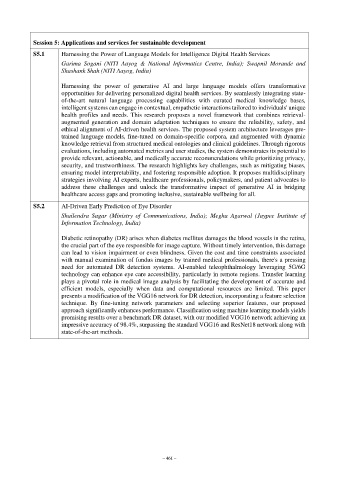Page 505 - Kaleidoscope Academic Conference Proceedings 2024
P. 505
Session 5: Applications and services for sustainable development
S5.1 Harnessing the Power of Language Models for Intelligence Digital Health Services
Garima Sogani (NITI Aayog & National Informatics Centre, India); Swapnil Morande and
Shashank Shah (NITI Aayog, India)
Harnessing the power of generative AI and large language models offers transformative
opportunities for delivering personalized digital health services. By seamlessly integrating state-
of-the-art natural language processing capabilities with curated medical knowledge bases,
intelligent systems can engage in contextual, empathetic interactions tailored to individuals' unique
health profiles and needs. This research proposes a novel framework that combines retrieval-
augmented generation and domain adaptation techniques to ensure the reliability, safety, and
ethical alignment of AI-driven health services. The proposed system architecture leverages pre-
trained language models, fine-tuned on domain-specific corpora, and augmented with dynamic
knowledge retrieval from structured medical ontologies and clinical guidelines. Through rigorous
evaluations, including automated metrics and user studies, the system demonstrates its potential to
provide relevant, actionable, and medically accurate recommendations while prioritizing privacy,
security, and trustworthiness. The research highlights key challenges, such as mitigating biases,
ensuring model interpretability, and fostering responsible adoption. It proposes multidisciplinary
strategies involving AI experts, healthcare professionals, policymakers, and patient advocates to
address these challenges and unlock the transformative impact of generative AI in bridging
healthcare access gaps and promoting inclusive, sustainable wellbeing for all.
S5.2 AI-Driven Early Prediction of Eye Disorder
Shailendra Sagar (Ministry of Communications, India); Megha Agarwal (Jaypee Institute of
Information Technology, India)
Diabetic retinopathy (DR) arises when diabetes mellitus damages the blood vessels in the retina,
the crucial part of the eye responsible for image capture. Without timely intervention, this damage
can lead to vision impairment or even blindness. Given the cost and time constraints associated
with manual examination of fundus images by trained medical professionals, there's a pressing
need for automated DR detection systems. AI-enabled teleophthalmology leveraging 5G/6G
technology can enhance eye care accessibility, particularly in remote regions. Transfer learning
plays a pivotal role in medical image analysis by facilitating the development of accurate and
efficient models, especially when data and computational resources are limited. This paper
presents a modification of the VGG16 network for DR detection, incorporating a feature selection
technique. By fine-tuning network parameters and selecting superior features, our proposed
approach significantly enhances performance. Classification using machine learning models yields
promising results over a benchmark DR dataset, with our modified VGG16 network achieving an
impressive accuracy of 98.4%, surpassing the standard VGG16 and ResNet18 network along with
state-of-the-art methods.
– 461 –

